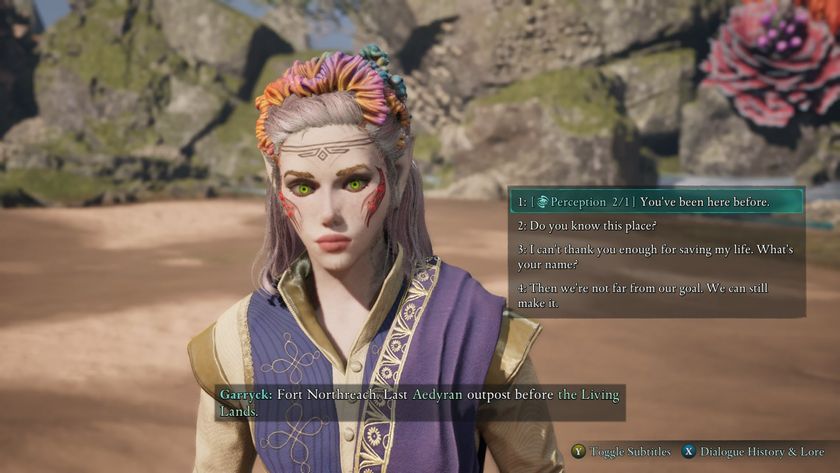Genshin Impact 3.0 is better than most open-world games and it's totally free
Genshin Impact's Sumeru region alone can go toe-to-toe with entire open-world games

Genshin Impact 3.0 is live, which means it's time for me to dig out my "Please try Genshin Impact" drum and beat another 1,000 words out of it. It's wild to think I've been doing this pretty regularly ever since I got unexpectedly hooked after Genshin's September 2020 launch. The game just keeps getting better, and 3.0 is the best version by far. I'd go as far to say that exploring the new region of Sumeru has been one of the best open-world experiences I've had in years. Sumeru already has enough content to match many of the premium open-world games I've played, and it's still got several huge updates in the works which will add a whole desert biome and likely turn this into the biggest region in Teyvat.
Wake up and smell the rainforest

One thing Genshin has always done incredibly well is encourage and reward curiosity through its world-building, and that's especially true in Sumeru. The region justifies its size by covering environments with meaningful discoveries that continually pull you forward – and often upward and downward, as there's some extreme verticality in many areas. It could be something as minor as looting a treasure chest, or as important as helping a forest ranger and accidentally starting a side quest chain so massive that it comes with its own quest log. All these findings make the world feel alive and make you wonder what you'll find next, which keeps you eager to see what's over the next hill or at the bottom of the next cave. It's also nice to see games still reveling in putting chests behind waterfalls and atop giant trees. No it doesn't make a bit of sense, but it's fun.
I'll say it until I'm hoarse: a grappling hook improves almost everything.
The secret sauce that really makes Sumeru stand out is that it's built more like a 3D platformer than previous regions. The whole game has floating collectibles and what not (peep those Genshin Impact Dendroculus locations here), but Sumeru is more fun to explore in an interactive and kinetic way. There are bouncy mushrooms that you can hit with electricity to make them extra bouncy, and golden flowers that replenish your stamina line cliffs and trees, making them more forgiving to climb. The best and most impactful addition is the zipline you can use to cover a lot of ground or scale great heights quickly. You need anchors to grapple onto, but these are all over the place and you can often spawn more by whacking specific plants, usually as a shortcut to hard-to-reach areas. I'll say it until I'm hoarse: a grappling hook improves almost everything.
The interactables around Sumeru leverage Genshin's elemental combat system in a cool way while teaching you about the new Dendro element – which has made combat feel more complete and buffed some old and weak characters – plus the ziplines save time while freeing you up to idly appreciate the sights and sounds of the region as you glide along. (I maintain that Genshin has been producing some of the best music in games for years, and now developer Hoyoverse has only gone and added a sitar to the orchestra.) There's also a strong visual language and mechanical throughline to the forest's micro-puzzles. You start to intuit when things are curiously out of place and how you might need to arrange or activate objects to proceed. Part of me wants to see trickier puzzles, but the other part of me might get fatigued if everything was a head-scratcher, so I digress.
Mild story spoilers ahead

Sumeru's world is also aided by arguably the best story quest in Genshin Impact to date. I liked Inazuma's main story because it totally flipped the relationship between the player and the local archon, with Raiden Shogun essentially treating you as a criminal most of the time. However, it also struggled to fit a lot of backstory into a short period and balance that with new events. This left Inazuma feeling a bit rushed, with many of the region's most important events so ancient or just so enormous that it was hard to really absorb their impact. Oftentimes an immeasurable tragedy that happens off-screen is less affecting than the death of one character you personally got to know, and update 3.0 recognizes that.
Sumeru's story also frames a fascinating relationship with the regional archon. Nahida is a relatively young deity pursuing her ideal godhood as she goes ignored by the secular academia that quietly controls the region. Importantly, the story quests in 3.0 avoid the pacing problems of Inazuma by using a smaller subplot that directly involves Nahida and you, the player, to paint a broader picture. This quest also does a pretty good job of assigning meaningful roles to side characters who will eventually be released as playable units to Wish for, which is a big part of what makes Genshin's cast so endearing.

Without spoiling too much, the second half of Sumeru's main story basically turns into a Groundhog Day situation. It's easy for this looping premise to get repetitive or heavy-handed, but Genshin handles it with enough care to hold the player's attention and keep them guessing. It's a fun mystery, and the backdrop to this quest tells you a lot about the de facto leaders of Sumeru and what – or who – they're willing to sacrifice for the sake of nebulous progress. This in turn shapes your understanding of peculiarities like the collective unconscious-equipped AirPods conspicuously given to all Sumeru citizens (don't ask; we're getting into Psycho Pass territory now and I don't have time to explain).
Sign up to the 12DOVE Newsletter
Weekly digests, tales from the communities you love, and more
It's good stuff! I mean, it's bad news for individualism in Sumeru and it doesn't have a damn thing to do with our hero's estranged sibling (who Genshin occasionally pretends to care about in between much more interesting stories), but it's good fuel for a new storyline. Visually, mechanically, and narratively, Sumeru positively pops. It's an entire game worth of content added onto an already gigantic world that's totally free to play. As someone who's prone to open-world fatigue, I still can't believe how much or how long I've been playing Genshin and how eagerly I look forward to playing more. I can't wait to spend more time in Sumeru, meet and build new characters, and – hopefully beginning in update 3.1 – feel the sand between my toes.

Austin has been a game journalist for 12 years, having freelanced for the likes of PC Gamer, Eurogamer, IGN, Sports Illustrated, and more while finishing his journalism degree. He's been with 12DOVE since 2019. They've yet to realize his position is a cover for his career-spanning Destiny column, and he's kept the ruse going with a lot of news and the occasional feature, all while playing as many roguelikes as possible.

10 years after Yakuza 0, Majima's swashbuckling return finally puts a bowline knot on decades of character growth

Final Fantasy 14's funniest speedrunning beef continues as runner who lost a world record to its original champ in just 1 day returns, beats record, is promptly dethroned again










